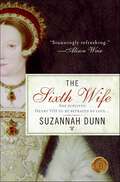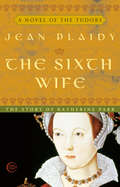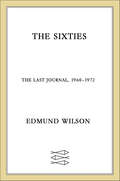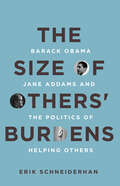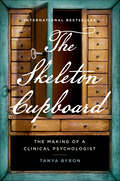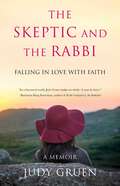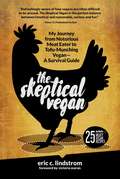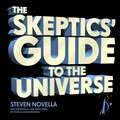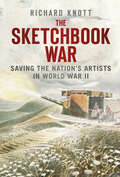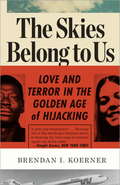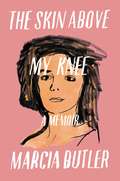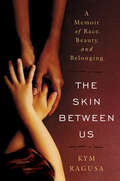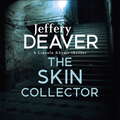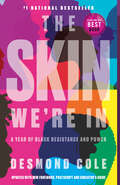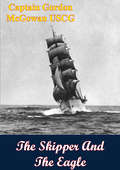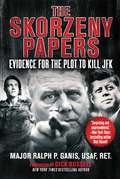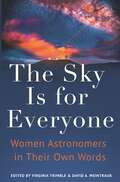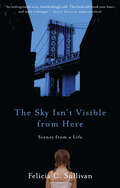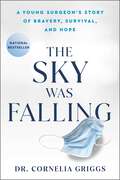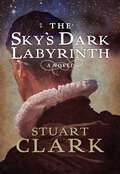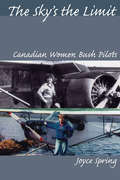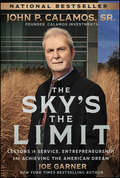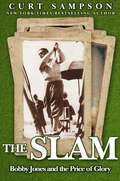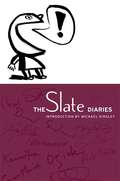- Table View
- List View
The Sixth Wife: A Novel
by Suzannah DunnA gripping novel of love, passion, betrayal, and heartbreak in the unstable Tudor court following the death of King Henry VIIIClever, level-headed Katherine Parr has suffered through four years of marriage to the aging and irascible King Henry VIII—and she has survived, unlike the five wives who came before her. But less than a year after the old king's death, her heart is won by the dashing Thomas Seymour, and their hasty union undoes a lifetime of prudent caution.An unwilling witness to the queen's late-blossoming love, Catherine, Duchess of Suffolk, harbors nagging suspicions of Kate's handsome and ambitious new husband. But as Catherine is drawn deeper into the web of politics ensnaring her oldest friend, it gradually becomes clear that she has her own dark tale to tell. For though Thomas might betray his wife for power, Catherine might betray her for passion, risking everything she has in a world where love is a luxury not even royalty can easily afford.
The Sixth Wife: The Story of Katherine Parr (Tudor Saga #7)
by Jean PlaidyDangerous court intrigue and affairs of the heart collide as renowned novelist Jean Plaidy tells the story of Katherine Parr, the last of Henry VIII's six queens.Henry VIII's fifth wife, Katherine Howard, was both foolish and unfaithful, and she paid for it with her life. Henry vowed that his sixth wife would be different, and she was. Katherine Parr was twice widowed and thirty-one years old. A thoughtful, well-read lady, she was known at court for her unblemished reputation and her kind heart. She had hoped to marry for love and had set her heart on Thomas Seymour, the dashing brother of Henry's third queen. But the aging king--more in need of a nurse than a wife--was drawn to her, and Katherine could not refuse his proposal of marriage.Queen Katherine was able to soothe the King's notorious temper, and his three children grew fond of her, the only mother they had ever really known. Trapped in a loveless marriage to a volatile tyrant, books were Katherine's consolation. But among her intellectual pursuits was an interest in Lutheranism--a religion that the king saw as a threat to his supremacy as head of the new Church of England. Courtiers envious of the Queen's influence over Henry sought to destroy her by linking her with the "radical" religious reformers. Henry raged that Katherine had betrayed him, and had a warrant drawn up for her arrest and imprisonment. At court it was whispered that the king would soon execute yet another wife. Henry's sixth wife would have to rely on her wits to survive where two other women had perished. . . .From the Trade Paperback edition.
The Sixties: The Last Journal, 1960-1972
by Lewis M. Dabney Edmund O. WilsonEdited by Wilson's biographer, this volume poignantly -- and defiantly -- records the final years of one of our foremost critics and writers, taking its place alongside his major works, including "To the Finland Station", "Patriotic Gore", "The Shores of Light, and Letters on Literature and Politics", as an enduring contribution to American culture. In "The Sixties" Wilson also struggles with his aging, as intellectual and personal curiosity contend against weakening physical powers, and flirtations that afford a sense of biological revival strain his relationship with his wife, Elena. He watches his children establishing their own lives and is aware of unfulfilled relationships with them. Yet, as he plunges into the contemporary scene of art, thought, and public affairs, the pull of his personal and cultural past is strengthened by the sense of his approaching end. Witnessing his own foibles and the ironies of human nature, expressing feeling more deeply than he often had in his journal, he writes his account of this decade with a concentration undiluted by other large-scale projects. The extraordinary personal record begun in another pivotal period in American life, with "The Twenties", comes to a fitting culmination in "The Sixties".
The Sixties: The Last Journal, 1960–1972 (Edmund Wilson's Notebooks and Diaries)
by Edmund WilsonThe last of Edmund Wilson's posthumously published journals turned out to be one of his major books, The Sixties: the Last Journal, 1960–1972--a personal history that is also brilliant social comedy and an anatomy of the times. Wilson catches the flavor of an international elite -- Stravinsky, Auden, Andre Malraux, and Isaiah Berlin -- as well as the New York literati and the Kennedy White House, but he never strays too far from the common life, whether noting the routines of his normal neighbors or the struggle of his own aging."Candor and intelligence come through on every page--in this always absorbing journal by perhaps the last great man of American letters." - Kirkus Reviews
The Size of Others' Burdens: Barack Obama, Jane Addams, and the Politics of Helping Others
by Erik SchneiderhanAmericans have a fierce spirit of individualism. We pride ourselves on self-reliance, on bootstrapping our way to success. Yet, we also believe in helping those in need, and we turn to our neighbors in times of crisis. The tension between these competing values is evident, and how we balance between these competing values holds real consequences for community health and well-being. In his new book, The Size of Others' Burdens, Erik Schneiderhan asks how people can act in the face of competing pressures, and explores the stories of two famous Americans to develop present-day lessons for improving our communities. Although Jane Addams and Barack Obama are separated by roughly one hundred years, the parallels between their lives are remarkable: Chicago activists-turned-politicians, University of Chicago lecturers, gifted orators, crusaders against discrimination, winners of the Nobel Peace Prize. Addams was the founder of Hull-House, the celebrated American "settlement house" that became the foundation of modern social work. Obama's remarkable rise to the presidency is well known. Through the stories of Addams's and Obama's early community work, Erik Schneiderhan challenges readers to think about how many of our own struggles are not simply personal challenges, but also social challenges. How do we help others when so much of our day-to-day life is geared toward looking out for ourselves, whether at work or at home? Not everyone can run for president or win a Nobel Prize, but we can help others without sacrificing their dignity or our principles. Great thinkers of the past and present can give us the motivation; Addams and Obama show us how. Schneiderhan highlights the value of combining today's state resources with the innovation and flexibility of Addams's time to encourage community building. Offering a call to action, this book inspires readers to address their own American dilemma and connect to community, starting within our own neighborhoods.
The Skeleton Cupboard: The Making of a Clinical Psychologist
by Tanya ByronThe gripping, unforgettable, and deeply affecting story of a young clinical psychologist learning how she can best help her patients, The Skeleton Cupboard is a riveting and revealing memoir that offers fascinating insight into the human mind. In The Skeleton Cupboard, Professor Tanya Byron recounts the stories of the patients who most influenced her career as a mental health practitioner. Spanning her years of training—years in which Byron was forced her to contend with the harsh realities of the lives of her patients and confront a dark moment in her own family's past—The Skeleton Cupboard is a compelling and compassionate account of how much health practitioners can learn from those they treat. Among others, we meet Ray, a violent sociopath desperate to be shown tenderness and compassion; Mollie, a talented teenager intent on starving herself; and Imogen, a twelve-year old so haunted by a secret that she's intent on killing herself. Byron brings the reader along as she uncovers the reasons each of these individuals behave the way they do, resulting in a thrilling, compulsively readable psychological mystery that sheds light on mental illness and what its treatment tells us about ourselves.
The Skeptic and the Rabbi: Falling in Love with Faith
by Judy GruenAs Judy Gruen walked down the aisle and into her Orthodox Jewish future, her bouquet quivered in her shaky hand. Having grown up in the zeitgeist that proclaimed, &“If it feels good, do it,&” was she really ready to live the life of &“rituals, rules, and restraints&” that the Torah prescribed? The Skeptic and the Rabbi is a rare memoir with historical depth, spirituality, and intelligent humor. Gruen speaks with refreshing honesty about what it means to remain authentic to yourself while charting a new yet ancient spiritual path at odds with the surrounding culture, and writes touchingly about her family, including her two sets of grandparents, who influenced her in wildly opposite ways. As she navigates her new life with the man she loves and the faith she also loves—surviving several awkward moments, including when the rabbi calls to tell her that she accidentally served unkosher food to her Shabbat guests—Gruen brings the reader right along for the ride. Reading this wry, bold and compelling memoir, you&’ll laugh, you&’ll cry, and when you&’re finished, you may also have a sudden craving for chicken matzo ball soup—kosher, of course.
The Skeptical Vegan: My Journey from Notorious Meat Eater to Tofu-Munching Vegan—A Survival Guide
by Victoria Moran Eric C. LindstromPETA's 2017 Vegan Cookbooks We Can’t Cook WithoutVegan Confessions of an Ex-Omnivore and His Survival Guide to Living Fully (Literally and Metaphorically).Growing up in an all-women household and coddled endlessly by his Italian mother and grandmother, Eric Lindstrom was nourished to obesity on meaty sauces, fried eggs, and butter-laden cookies. After spending the first half of his life as an adamant omnivore, Lindstrom went 100% vegan. Reluctantly. Overnight. From burgers to beets, from pork to parsnips.It’s time for a down-to-earth book that proves anyone can go vegan (even someone who once ate sixty-eight chicken wings in a sitting). How can a man adopt a vegan approach? Won’t he die of protein deficiency? What if he is married to a vegan woman? How would he order a salad at a Minnesota steakhouse? What should he bring to a gluten-free, nut-free, macrobiotic, nightshade-free, oil-free, vegan potluck (true story)?Part confession and part survival guide, The Skeptical Vegan explains how simple it really is to be vegan, covering topics from food and nutrition to social challenges and lifestyle. Snarky, witty, and opinionated to a fault, Lindstrom speaks as a male vegan, contesting the notion that "real men” should only eat meat. With twenty original "veganized” recipes including portobello steaks, carrot hot dogs, tofu wings, "meaty” chili, and cauliflower bites (which helped him shed thirty pounds), Lindstrom demonstrates how to take control of your diet while still eating "meatily” and taking into account the ethical considerations of living a better life for the animals, the environment, and yourself.
The Skeptics' Guide to the Universe: How To Know What's Really Real in a World Increasingly Full of Fake
by Steven Novella'A fantastic compendium of skeptical thinking and the perfect primer for anyone who wants to separate fact from fiction.' Richard Wiseman, author 59 Seconds'Thorough, informative, and enlightening... If this book does not become required reading for us all, we may well see modern civilization unravel before our eyes.' Neil deGrasse Tyson, author of Astrophysics for People in a HurryAn entertaining and all-encompassing guide to skeptical thinking for the age of misinformation.In this tie-in to their popular 'The Skeptics Guide to the Universe' podcast, Steven Novella, along with 'Skeptical Rogues' Bob Novella, Cara Santa Maria, Jay Novella and Evan Bernstein explain the tenets of skeptical thinking and debunk some of the biggest scientific myths, fallacies and conspiracy theories (anti-vaccines, homeopathy, UFO sightings, and many more.) They'll help us try to make sense of what seems like an increasingly crazy world using powerful tools like science and philosophy. The Skeptics' Guide to the Universe is your guide through this maze of modern life. It covers essential critical thinking skills, as well as giving insight into how your brain works and how to avoid common pitfalls in thinking. They discuss the difference between science and pseudoscience, how to recognize common science news tropes, how to discuss conspiracy theories with that crazy colleague of yours, and how to apply all of this to everyday life.As fascinating as it is entertaining, this page turner is your essential guide to seeing through the fake news and media manipulation in our increasingly confusing world.(P)2018 Hachette Audio
The Sketchbook War: Saving the Nation's Artists in World War II
by Richard KnottDuring the Second World War, British artists produced over 6,000 works of war art, the result of a government scheme partly designed to prevent the artists being killed. This book tells the story of nine courageous war artists who ventured closer to the front line than any others in their profession.Edward Ardizzone, Edward Bawden, Barnett Freedman, Anthony Gross, Thomas Hennell, Eric Ravilious, Albert Richards, Richard Seddon and John Worsley all travelled abroad into the dangers of war to chronicle events by painting them. They formed a close bond, yet two were torpedoed, two were taken prisoner and three died, two in 1945 when peacetime was at hand. Men who had previously made a comfortable living painting in studios were transformed by military uniforms and experiences that were to shape the rest of their lives, and their work significantly influenced the way in which we view war today.Portraying how war and art came together in a moving and dramatic way, and incorporating vivid examples of their paintings, this is the true story behind the war artists who fought, lived and died for their art on the front line of the Second World War.
The Skies Belong to Us: Love and Terror in the Golden Age of Hijacking
by Brendan I. KoernerIn an America torn apart by the Vietnam War and the demise of '60s idealism, airplane hijackings were astonishingly routine. Over a five-year period starting in 1968, the desperate and disillusioned seized commercial jets nearly once a week, using guns, bombs, and jars of acid. Some hijackers wished to escape to foreign lands; others aimed to swap hostages for sacks of cash. Their criminal exploits mesmerized the country, never more so than when shattered Army veteran Roger Holder and mischievous party girl Cathy Kerkow managred to comandeer Western Airlines Flight 701 and flee across an ocean with a half-million dollars in ransom--a heist that remains the longest-distance hijacking in American history.More than just an enthralling story about a spectacular crime and its bittersweet, decades-long aftermath, The Skies Belong to Us is also a psychological portrait of America at its most turbulent and a testament to the madness that can grip a nation when politics fail. tale, which involves a cast of characters ranging from exiled Black Panthers to African despots to French movie stars. He combed through over 4,000 declassified documents and interviewed scores of key figures in the drama--including one of the hijackers, whom Koerner discovered living in total obscurity. Yet The Skies Belong to Us is more than just an enthralling yarn about a spectacular heist and its bittersweet, decades-long aftermath. It is also a psychological portrait of America at its most turbulent, and a testament to the madness that can grip a nation when politics fail.
The Skin Above My Knee
by Marcia ButlerThe unflinching story of a professional oboist who finds order and beauty in music as her personal life threatens to destroy her.Music was everything for Marcia Butler. Growing up in an emotionally desolate home with an abusive father and a distant mother, she devoted herself to the discipline and rigor of the oboe, and quickly became a young prodigy on the rise in New York City's competitive music scene. But haunted by troubling childhood memories while balancing the challenges of a busy life as a working musician, Marcia succumbed to dangerous men, drugs and self-destruction. In her darkest moments, she asked the hardest question of all: Could music truly save her life?A memoir of startling honesty and subtle, profound beauty, The Skin Above My Knee is the story of a woman finding strength in her creative gifts and artistic destiny. Filled with vivid portraits of 1970's New York City, and fascinating insights into the intensity and precision necessary for a career in professional music, this is more than a narrative of a brilliant musician struggling to make it big in the big city. It is the story of a survivor.
The Skin Between Us: A Memoir of Race, Beauty, and Belonging
by Kym RagusaA memoir of astonishing delicacy and strength about race and physical beauty. Kym Ragusa's stunningly beautiful, brilliant black mother constantly turned heads as she strolled the streets of West Harlem. Ragusa's working-class white father, who grew up only a few streets (and an entire world) away in Italian East Harlem, had never seen anyone like her. At home their families despaired at the match, while in the streets the couple faced taunting threats from a city still racially divided--but they were mesmerized by the differences between them. From their volatile, short-lived pairing came a sensitive child with a filmmaker's observant eye. Her two powerful grandmothers gave her the love and stability to grow into her own skin. Eventually, their shared care for their granddaughter forced them to overcome their prejudices. Rent parties and religious feste, baked yams and baked ziti--Ragusa's sensuous memories are a reader's delight, as they bring to life the joy, pain, and inexhaustible richness of a racially and culturally mixed heritage.
The Skin Collector: Lincoln Rhyme Book 11 (Lincoln Rhyme Thrillers #11)
by Jeffery DeaverA new type of serial killer is stalking the streets of New York - one more devious and disturbing than ever before.They call this butcher The Skin Collector: a tattooist with a chamber of torture hidden deep underground. But instead of using ink to create each masterpiece, the artist uses a lethal poison which will render targets dead before they can even entertain the prospect of escape...Drafted in to investigate, NYPD detective Lincoln Rhyme and his associate Amelia Sachs have little to go on but a series of cryptic messages left etched into the skin of the deceased. As the pair struggle to discover the meaning behind the designs, they are led down a treacherous and twisting path where nothing is as it seems. And with the clock rapidly ticking before the killer strikes again, they must untangle the twisted web of clues before more victims - or they themselves - are next.(P)2014 Hodder & Stoughton
The Skin We're In: A Year of Black Resistance and Power
by Desmond ColeA bracing, provocative, and perspective-shifting book from one of Canada's most celebrated and uncompromising writers, Desmond Cole. The Skin We're In will spark a national conversation, influence policy, and inspire activists. <P><P>In his 2015 cover story for Toronto Life magazine, Desmond Cole exposed the racist actions of the Toronto police force, detailing the dozens of times he had been stopped and interrogated under the controversial practice of carding. The story quickly came to national prominence, shaking the country to its core and catapulting its author into the public sphere. Cole used his newfound profile to draw insistent, unyielding attention to the injustices faced by Black Canadians on a daily basis. <P><P>Both Cole’s activism and journalism find vibrant expression in his first book, The Skin We’re In. Puncturing the bubble of Canadian smugness and naive assumptions of a post-racial nation, Cole chronicles just one year—2017—in the struggle against racism in this country. It was a year that saw calls for tighter borders when Black refugees braved frigid temperatures to cross into Manitoba from the States, Indigenous land and water protectors resisting the celebration of Canada’s 150th birthday, police across the country rallying around an officer accused of murder, and more. <P><P>The year also witnessed the profound personal and professional ramifications of Desmond Cole’s unwavering determination to combat injustice. In April, Cole disrupted a Toronto police board meeting by calling for the destruction of all data collected through carding. Following the protest, Cole, a columnist with the Toronto Star, was summoned to a meeting with the paper’s opinions editor and informed that his activism violated company policy. Rather than limit his efforts defending Black lives, Cole chose to sever his relationship with the publication. Then in July, at another police board meeting, Cole challenged the board to respond to accusations of a police cover-up in the brutal beating of Dafonte Miller by an off-duty police officer and his brother. When Cole refused to leave the meeting until the question was publicly addressed, he was arrested. The image of Cole walking out of the meeting, handcuffed and flanked by officers, fortified the distrust between the city’s Black community and its police force. <P><P>Month-by-month, Cole creates a comprehensive picture of entrenched, systemic inequality. Urgent, controversial, and unsparingly honest, The Skin We’re In is destined to become a vital text for anti-racist and social justice movements in Canada, as well as a potent antidote to the all-too-present complacency of many white Canadians.
The Skipper And The Eagle
by Captain Gordon McGowan USCGCOMMANDER Gordon McGowan, cast in the role of master of a three-masted bark by order of the U.S. Coast Guard, found himself short on square rigged sailing knowledge and long on re-fitting problems when faced with transforming a battered German prize of war, the Horst Wessel, into a well-found Coast Guard training ship, the Eagle.The period was the end of the Second World War; the place was bomb-shattered Bremerhaven.In the SKIPPER AND THE EAGLE you'll meet "Doc," a dentist with a burning ambition to remove an appendix at sea; "Ducky," an internationally known ocean racing yachtsman, now a naval officer dividing up ships of the German navy among the Allies. There's a decidedly practical, if unorthodox, British Naval officer who assigns German seamen to Cmdr. McGowan in his search for men to augment his short-handed and inexperienced crew of graduates from boot camp.Cmdr. McGowan (now Capt. Rtd) was the only Coast Guard officer in Germany, a fact which gave rise to a series of amusing episodes. Furthermore, he had been brought up in steam vessels, and his knowledge of sailing ships left much to be desired. In fact, he feels that knowledgeable sailors should read this book if only to feel vastly superior to the author! He has a fully developed sense of humor and a talent for understatement which makes his book delightful reading.When the Eagle was finally made ready for sea, she took off through the mine fields of the North Sea and English Channel. Then under sail, to Funchal, Madeira, where the skipper had his first harrowing experience with rigid protocol. The Eagle enjoyed a long downhill run with the Trade Winds to Bermuda.On the voyage from Bermuda to New York the Eagle was caught in a full-fledged hurricane and the description of this ranks near the top of sea-going literature.The SKIPPER AND THE EAGLE is hearty fare for all with a love of the sea, ships, and the men who sail them. There isn't a dull page in it.
The Skorzeny Papers: Evidence for the Plot to Kill JFK
by Dick Russell Ret. Major Ralph P. Ganis UsafIn The Skorzeny Papers, the author reveals the details of the post-World War II activities of former SS Commando Otto Skorzeny. Considered by British and American Allied forces as “the most dangerous man in Europe,” Skorzeny planned and led numerous daring missions throughout the war. The story in this book was extracted by Major Ganis from Skorzeny’s personal papers. The evidence reveals that Skorzeny gradually and methodically became involved in US intelligence and covert operations during the Cold War. But Skorzeny’s network had a greater point of destiny in November 1963, when it was utilized to carry out the most tragic mission in history. This story would have been lost had Skorzeny not kept meticulous records of his businesses and contacts, which were fronts for US covert activity. In the end, The Skorzeny Papers reveal the intriguing web of secret organizations and people linked to the events culminating in the assassination of President John F. Kennedy.
The Sky Is for Everyone: Women Astronomers in Their Own Words
by Virginia Trimble and David A. WeintraubThe Sky Is for Everyone is an internationally diverse collection of autobiographical essays by women who broke down barriers and changed the face of modern astronomy. Virginia Trimble and David Weintraub vividly describe how, before 1900, a woman who wanted to study the stars had to have a father, brother, or husband to provide entry, and how the considerable intellectual skills of women astronomers were still not enough to enable them to pry open doors of opportunity for much of the twentieth century. After decades of difficult struggles, women are closer to equality in astronomy than ever before. Trimble and Weintraub bring together the stories of the tough and determined women who flung the doors wide open. Taking readers from 1960 to today, this triumphant anthology serves as an inspiration to current and future generations of women scientists while giving voice to the history of a transformative era in astronomy. <p><p> With contributions by Neta A. Bahcall, Beatriz Barbuy, Ann Merchant Boesgaard, Jocelyn Bell Burnell, Catherine Cesarsky, Poonam Chandra, Xuefei Chen, Cathie Clarke, Judith Gamora Cohen, France Anne Córdova, Anne Pyne Cowley, Bożena Czerny, Wendy L. Freedman, Yilen Gómez Maqueo Chew, Gabriela González, Saeko S. Hayashi, Martha P. Haynes, Roberta M. Humphreys, Vicky Kalogera, Gillian Knapp, Shazrene S. Mohamed, Carole Mundell, Priyamvada Natarajan, Dara J. Norman, Hiranya Peiris, Judith Lynn Pipher, Dina Prialnik, Anneila I. Sargent, Sara Seager, Gražina Tautvaišienė, Silvia Torres-Peimbert, Virginia Trimble, Meg Urry, Ewine F. van Dishoeck, Patricia Ann Whitelock, Sidney Wolff, and Rosemary F. G. Wyse.
The Sky Isn't Visible from Here: Scenes from a Life
by Felicia C. SullivanA young woman from Brooklyn “looks at her rocky childhood growing up with a beautiful, drug-addicted mom” in this remarkable memoir (Vanity Fair). Felicia Sullivan’s mother disappeared on the night Felicia graduated from college. The daughter would go on to an Ivy League education and numerous accomplishments—but eventually, just like her missing parent, she would succumb to alcohol and cocaine abuse. In this “brave and lovely” account, Felicia looks at the ways she was shaped by the shame of her past, and how she finally overcame it (Roxana Robinson). Looking back on the tough streets of Brooklyn in the 1980s, where she lived among drug dealers, users, and substitute fathers who tended to be indifferent at best and abusive at worst, Felicia reveals how she became her mother’s keeper, taking her to the hospital when she overdosed, withstanding her narcissistic rages, and always wondering why her mother would never reveal the truth about the father she’d never met. The Sky Isn’t Visible from Here is a testament to the resilience of the human spirit, and an “extraordinary memoir [that] will keep you awake at night and haunt your dreams” (Dani Shapiro, author of Family History).
The Sky Was Falling: A Young Surgeon's Story of Bravery, Survival, and Hope
by Dr. Cornelia GriggsA NATIONAL BESTSELLER In this &“essential work that provides lasting insights and lessons for the individual and society&” (Jerome Groopman, MD, New York Times bestselling author), a young pediatric surgeon and mother reveals her dramatic, cathartic diary, written as she worked on the front lines of the COVID-19 pandemic at one of New York City&’s busiest hospitals. For many of us, the experience of the peak pandemic was eerily incongruous. We were sequestered in our quiet homes but reminded of the devastation by the never-ending ping of news alerts. Dr. Cornelia Griggs&’s experience was altogether different. A pediatric surgery fellow in New York City, she was entering the final victory lap at the end of nine grueling years of training. She was set for a big graduation celebration and looking forward to spending some real time with her husband and kids. Then came COVID-19. Initially, Griggs encouraged her friends and family not to panic. However, as mysterious cases began showing up in the hospital, and then hospital supplies started disappearing from shelves, she couldn&’t hold back the feeling that this was going to be worse than she had thought. She wrote a startling op-ed in The New York Times called &“The Sky Is Falling&” that went, for lack of a better word, viral. The piece was read by over a million people, and Griggs appeared on CNN. Having once aspired to be a journalist, Griggs found that the only way to make sense of what she was witnessing around her and maintain her sanity was to keep a diary. The Sky Was Falling is her day-to-day account of what most of us were grateful to only see in the news—the sharply increasing case numbers, the dwindling supply of respirators, the lack of clarity on how to treat this new disease. Harrowing, deeply personal, and page-turning in the way of the best medical memoirs, it tells the story of healthcare professionals who went beyond what they thought they were capable of to heal their patients, and themselves.
The Sky's Dark Labyrinth: A Novel (The\sky's Dark Labyrinth Trilogy Ser. #2)
by Stuart ClarkIntrigue and danger threaten two Renaissance astronomers in this historical novel of Galileo, Kepler, and their quest to understand the universe. At the dawn of the 17th century, it was believed that the Sun revolved around the Earth. Yet some men knew that the Heavens did not move as they should. They began to believe exactly the opposite, a heresy punishable by being burned alive. The Sky's Dark Labyrinth follows the stories of Johannes Kepler and Galileo Galilei—two men of science who pursue the light of truth into dark and dangerous territory. Kepler, a German Lutheran, was the first man to demonstrate how stars and planets moved according to mathematical laws. Galileo, an Italian Catholic, tries to claim Kepler's success for his own Church. Both men are soon enmeshed in a web of intrigue orchestrated by forces within the Vatican itself. The Sky's Dark Labyrinth is the first novel in a trilogy that explores the personal and professional struggles of these iconic figures.
The Sky's the Limit: Canadian Women Bush Pilots
by Joyce SpringThe women pilots profiled in this book have flown from British Columbia to Newfoundland and in the Northwest Territories and Nunavut. Right from the beginning of her interviews and research, the author found herself constantly amazed by the achievements of the women involved. Within the book are the stories of early Canadian women bush pilots from the late 1940s onwards. Their stories are exciting, occasionally funny, and always absorbing. Ranging from aerial surveys, water bombing of fires, flying fish, canoes and northern dogs, to the operation of a float-plane flying school, these women have left little undone. One pilot, Judy Cameron, was the first Canadian woman to be hired by an airline. Flying north of Superior, Elizabeth Wieben recalls the time that she flew naked. In pilot Suzanne Pettigrew’s own words, "We sure have come a long way and the ride was an awful lot of fun."
The Sky's the Limit: Lessons in Service, Entrepreneurship, and Achieving the American Dream
by Joe Garner John P. Calamos Sr.Stories and lessons from John P. Calamos Sr., a rags-to-riches self-made American billionaire Sky's the Limit: Lessons in service, Entrepreneurship and Achieving the American Dream tells the inspirational tale of John P. Calamos Sr., an American trailblazer, self-made success story, and living legend in the world of investing. Each chapter contains stories and business lessons he learned along the way. From a stock boy in his parents' grocery store in Chicago's west side, to 400+ combat missions in Vietnam, to launching his own firm which now has upwards of $35 billion in assets, John's career and the extreme success he's enjoyed through that career have been built on taking risks and being resilient. Some of the events detailed in this book include: Teenage John's discovery of stock certificates in his family's basement ignites a passion for investing Major Calamos' time in the Air Force, including five years of active duty flying B-52 bombers and twelve years in the Reserves flying A-37 jet fighters Pioneering initiatives to launch one of the first convertible funds in 1985 and one of the first liquid alternative funds in 1990 Sky's the Limit: Lessons in Service, Entrepreneurship and Achieving the American Dream earns a well-deserved spot on the bookshelves of all individuals seeking to mirror the success of a man who is a living embodiment of the quintessential rags-to-riches American dream.
The Slam: Bobby Jones and the Price of Glory
by Curt SampsonAn unlikely champion. An unprecedented accomplishment. A powerful story of a man on the verge of becoming a legend—at a time when the nation needed every hero it could get. In the 1930s, Bobby Jones did what no golfer had done before—and what no golfer has done since—he won all four major championships in one year. This dominant performance earned him untold riches and the adoration of the public. He had two tickertape parades to commemorate his achievement. He dated starlets. He became one of the best paid men in the country at a time when the Depression had ravaged the economy.Then, at the top of his game, he quit the sport. He walked away.One of golf's greatest writers, the New York Times bestselling author Curt Sampson, focuses on the 1930 golf season and how Bobby Jones changed a country, how Jones exemplified an era, and how his own personal demons threatened to swallow him whole, even as he performed unparalleled feats on the greens.A must-have for golf fans, THE SLAM captures the essence of an era—equal parts compelling sports biography, sweeping social history, and stirring human drama.
The Slate Diaries
by Judith Shulevitz Jodi Kantor Cyrus KroneEach week the editors of Slate, one of the on-line literary magazines, ask a different person to keep a diary. The Slate Diaries is a selection of some of the best of those diaries. Contributors include distinguished writers.
